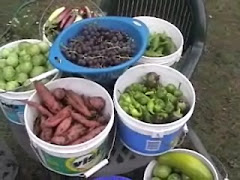You can read this fine story by Willa Cather in it's entirety online - 'O Pioneers!'
 Much like Mrs. Bergson we once again foraged, grew, and preserved with a devoted enthusiasm. I would suppose that the success of our garden could, in part, be based upon how much food was put by in the root cellar, canned, or saved through other means of preservation. If we were to judge our gardening endeavours in this manner it would once again be deemed another prosperous season. The cellar contains an embarrassing amount of beets, carrots, potatoes, turnips, rutabagas, parsnips, celery, Belgian endive, root parsley, onions, kohlrabi, cabbage, peppers, and apples. Our warm dry living room is home to members of the cucurbit (squash) clan and yet another cool dry back room contains saved seeds for next year's garden, baskets of garlic, and even a few shallots.
Much like Mrs. Bergson we once again foraged, grew, and preserved with a devoted enthusiasm. I would suppose that the success of our garden could, in part, be based upon how much food was put by in the root cellar, canned, or saved through other means of preservation. If we were to judge our gardening endeavours in this manner it would once again be deemed another prosperous season. The cellar contains an embarrassing amount of beets, carrots, potatoes, turnips, rutabagas, parsnips, celery, Belgian endive, root parsley, onions, kohlrabi, cabbage, peppers, and apples. Our warm dry living room is home to members of the cucurbit (squash) clan and yet another cool dry back room contains saved seeds for next year's garden, baskets of garlic, and even a few shallots.This room is full of carrots, beets, and potatoes (not shown).
 We like to keep our onions in baskets as it helps with airflow.
We like to keep our onions in baskets as it helps with airflow. Atop our kitchen refrigerator one can find an assortment of glass gallon jars filled with various dry beans, corn, and fruit leather. The two freezers on our porch are both stuffed beyond capacity with foraged service berries, elderberries, Oregon grapes, huckleberries, cranberries, dried morel mushrooms, and cubes of hawthorn berry syrup. And from our garden - frozen strawberries, grapes, raspberries, black raspberries, blackberries, currants, gooseberries, josta berries, zucchini, broccoli, rhubarb sauce, dried apples, dried pears, dried apricots, more peppers, beet greens, kale greens, peas, stewed and dried plums, dried tomatoes, and herbs like cilantro and basil.
Atop our kitchen refrigerator one can find an assortment of glass gallon jars filled with various dry beans, corn, and fruit leather. The two freezers on our porch are both stuffed beyond capacity with foraged service berries, elderberries, Oregon grapes, huckleberries, cranberries, dried morel mushrooms, and cubes of hawthorn berry syrup. And from our garden - frozen strawberries, grapes, raspberries, black raspberries, blackberries, currants, gooseberries, josta berries, zucchini, broccoli, rhubarb sauce, dried apples, dried pears, dried apricots, more peppers, beet greens, kale greens, peas, stewed and dried plums, dried tomatoes, and herbs like cilantro and basil.
 The back pantry contains↓
The back pantry contains↓
1 large box full of grown and foraged tea herbs
Tomato sauce - 104 quarts (13 left from last year)
Thick spaghetti/pizza sauce - 52 pints
Various salsa derived from tomatoes, tomatillos, and combinations of both - 82 pints (6 left from last year)
Ketchup - 7 half pints & 10 pints (4 from last year)
Sauerkraut - 5 water bath canned, 9 unprocessed quarts in basement & 6 in the refrigerator
Nasturtium Capers (also called poor man's capers) - 2 half pints
Various whole and sliced pickles - 23 pints & 15 quarts
Green beans (pickled) -6 pints
Apple sauce - 11 quarts & 22 pints
Pear sauce - 6 quarts
Huckleberry Jam - 6 half pints left from last year
Mincemeat - 11 pints & 1 quart
Ginger pear sauce - (we love this on baked squash) 22 half pints & 5 pints
"...steam was generated beyond the power of the canister to endure. As a natural consequence, the canister burst, the dead turkey sprang from his coffin of tinplate and killed the cook forthwith." - News report of an early canning industry accident (1852)
Fortunately, no such bad luck has befallen us and of all the canned food processed this year only two empty jars were lost when the bottoms busted out because I failed to properly heat them before dunking into hot water to be scalded. All in all we are quite content with this year's harvest and are especially glad to be finished with the task of canning all our "green" tomatoes. Out of the estimated 500-600 lbs we harvested this year a remarkable majority of them ripened up nicely indoors. We just finished our last batch the day before Thanksgiving...Ay yi yi !
There will be no more warm jars for Rodger, the fat black cheshire cat, to cuddle up next to.
































